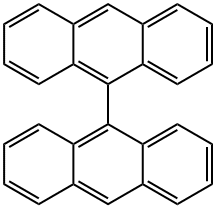4,4',4''-Tris(carbazol-9-yl)-triphenylamine
Synonym(s):TCTA
- CAS NO.:139092-78-7
- Empirical Formula: C54H36N4
- Molecular Weight: 740.89
- MDL number: MFCD03093250
- EINECS: 625-738-6
- SAFETY DATA SHEET (SDS)
- Update Date: 2024-01-05 11:48:35

What is 4,4',4''-Tris(carbazol-9-yl)-triphenylamine?
Description
Having three carbazole units as the pendants and triarylamine at the core,?tris(4-carbazoyl-9-ylphenyl)amine (TCTA) is electron-rich. As a result, it is widely used as a hole-transport and hole-injection material in light-emitting diodes and perovskite solar cells. With low electron mobility, TCTA has also been used as exciton/electron blocking layer materials because of its high lying LUMO energy level (LUMO = 2.4 eV).
Chemical properties
Light yellow solid
The Uses of 4,4',4''-Tris(carbazol-9-yl)-triphenylamine
4,4'',4''''-Tris(carbazol-9-yl)-triphenylamine has been patented for use in the preparation of light-emitting materials for organic electroluminescent devices.
Properties of 4,4',4''-Tris(carbazol-9-yl)-triphenylamine
| Melting point: | 298~300°C |
| Density | 1.23±0.1 g/cm3(Predicted) |
| storage temp. | Inert atmosphere,Room Temperature |
| form | powder to crystal |
| pka | -5.97±0.60(Predicted) |
| color | White to Orange to Green |
| λmax | 326nm(CH2Cl2)(lit.) |
| CAS DataBase Reference | 139092-78-7 |
| Absorption | λmax?293?and?326 nm (THF) |
Safety information for 4,4',4''-Tris(carbazol-9-yl)-triphenylamine
| Signal word | Warning |
| Pictogram(s) |
 Exclamation Mark Irritant GHS07 |
| GHS Hazard Statements |
H315:Skin corrosion/irritation H319:Serious eye damage/eye irritation H335:Specific target organ toxicity, single exposure;Respiratory tract irritation |
| Precautionary Statement Codes |
P261:Avoid breathing dust/fume/gas/mist/vapours/spray. P264:Wash hands thoroughly after handling. P264:Wash skin thouroughly after handling. P271:Use only outdoors or in a well-ventilated area. P280:Wear protective gloves/protective clothing/eye protection/face protection. P302+P352:IF ON SKIN: wash with plenty of soap and water. P305+P351+P338:IF IN EYES: Rinse cautiously with water for several minutes. Remove contact lenses, if present and easy to do. Continuerinsing. |
Computed Descriptors for 4,4',4''-Tris(carbazol-9-yl)-triphenylamine
| InChIKey | AWXGSYPUMWKTBR-UHFFFAOYSA-N |
New Products
4-Fluorophenylacetic acid 4-Methylphenylacetic acid N-Boc-D-alaninol N-BOC-D/L-ALANINOL Tert-butyl bis(2-chloroethyl)carbamate 3-Morpholino-1-(4-nitrophenyl)-5,6-dihydropyridin- 2(1H)-one Furan-2,5-Dicarboxylic Acid Tropic acid S-2-CHLORO PROPIONIC ACID ETHYL ISOCYANOACETATE 2-Bromo-1,3-Bis(Dimethylamino)Trimethinium Hexafluorophosphate (6-METHYL-[1,3]DITHIOLO[4,5-b]QUINOXALIN-2-ONE INDAZOLE-3-CARBOXYLIC ACID 4-IODO BENZOIC ACID (2-Hydroxyphenyl)acetonitrile 4-Bromopyrazole 5,6-Dimethoxyindanone 2-(Cyanocyclohexyl)acetic acid 4-methoxy-3,5-dinitropyridine 2-aminopropyl benzoate hydrochloride 1-(4-(aminomethyl)benzyl)urea hydrochloride diethyl 2-(2-((tertbutoxycarbonyl)amino) ethyl)malonate tert-butyl 4- (ureidomethyl)benzylcarbamate Ethyl-2-chloro((4-methoxyphenyl)hydrazono)acetateRelated products of tetrahydrofuran



![9-[3-(Dibenzo[b,d]furan-2-yl)phenyl]-9H-carbazole](https://img.chemicalbook.in/CAS/20180629/GIF/1338446-77-7.gif)


![9,9-bis[4-(pyrenyl)phenyl]-9H-fluorene](https://img.chemicalbook.in/CAS/GIF/1174006-47-3.gif)

You may like
-
 4,4',4''-Tri-9-carbazolyltriphenylamine (purified by sublimation) CAS 139092-78-7View Details
4,4',4''-Tri-9-carbazolyltriphenylamine (purified by sublimation) CAS 139092-78-7View Details
139092-78-7 -
 4,4',4''-Tri-9-carbazolyltriphenylamine CAS 139092-78-7View Details
4,4',4''-Tri-9-carbazolyltriphenylamine CAS 139092-78-7View Details
139092-78-7 -
 Tris-4-Carbazoyl-9-yl Phenylamine CAS 139092-78-7View Details
Tris-4-Carbazoyl-9-yl Phenylamine CAS 139092-78-7View Details
139092-78-7 -
 Tris(4-carbazoyl-9-ylphenyl)amine CAS 139092-78-7View Details
Tris(4-carbazoyl-9-ylphenyl)amine CAS 139092-78-7View Details
139092-78-7 -
 1975-50-4 98%View Details
1975-50-4 98%View Details
1975-50-4 -
 2-HYDROXY BENZYL ALCOHOL 98%View Details
2-HYDROXY BENZYL ALCOHOL 98%View Details
90-01-7 -
 14714-50-2 (2-Hydroxyphenyl)acetonitrile 98+View Details
14714-50-2 (2-Hydroxyphenyl)acetonitrile 98+View Details
14714-50-2 -
 118753-70-1 98+View Details
118753-70-1 98+View Details
118753-70-1
Statement: All products displayed on this website are only used for non medical purposes such as industrial applications or scientific research, and cannot be used for clinical diagnosis or treatment of humans or animals. They are not medicinal or edible.